DevOps plays a critical role in how modern tech companies build, test, and deploy software. For startups and growing businesses, it’s often the difference between delivering features consistently and falling behind due to bottlenecks or technical debt.
Still, one of the most common and valid questions is: How much does DevOps consulting cost in 2025?
There’s no single answer. Pricing can range from $5,000 for small-scale automation projects to over $50,000 for complete cloud-native and infrastructure overhauls. Without clear cost expectations, companies risk overspending or underinvesting in crucial areas.
This guide aims to provide startup founders, CTOs, and tech leaders with a clear understanding of DevOps consulting costs, typical pricing structures, budgeting strategies, and expected returns on investment. You’ll also find insights into hidden expenses, team models, and what to look for in a reliable consulting partner.
If you’re building internal systems, scaling delivery pipelines, or optimizing cloud operations, this guide will help you plan smarter and make confident, informed decisions.
Why Should Companies Invest in DevOps Consulting?
DevOps consulting delivers clear business value by enabling faster releases and more reliable systems. In fact, high-performing teams deploy code multiple times per day, resolve failures in under an hour, and experience fewer disruptions, all traits linked to lower change failure rates and higher engineering performance.
According to the 2024 State of DevOps Report by Google Cloud, elite teams consistently show these characteristics, making DevOps maturity a competitive differentiator for startups.
As companies grow, they often bring in DevOps specialists to tackle key challenges. For instance, rapid team scaling can strain existing CI/CD pipelines, triggering the need for automation and toolchain optimization. Migrating to the cloud or upgrading infrastructure architecture are further common catalysts. These are the moment-of-truth scenarios when DevOps consulting goes from “nice to have” to essential.
Table of Contents
Importantly, this investment considers not only the cost but also the return on investment. Measuring DevOps ROI for startups hinges on key metrics, including deployment frequency, mean time to recovery (MTTR), and change failure rate. Teams with advanced DevOps practices typically spend nearly 50% less time on unplanned work and rework, allowing them to allocate more time to building customer-facing features.
Which Factors Affect DevOps Consulting Costs in 2025?
Startups and growing tech companies can make more informed budgetary decisions by knowing what factors will influence DevOps consulting prices in 2025. A number of factors, such as engagement models and the complexity of cloud infrastructure, directly affect your ultimate cost.
In the following, we will break down each cost variable with clear examples, helping you budget realistically and assess ROI across different vendor models and use cases.
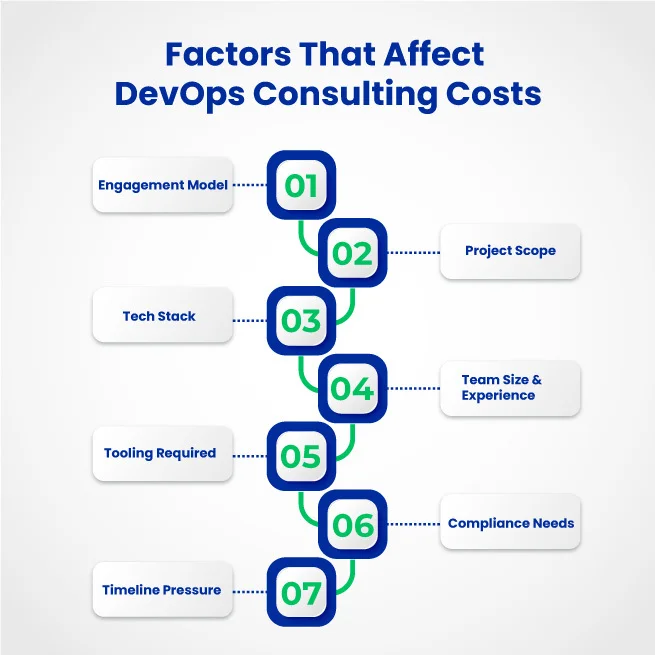
1. Engagement Models
DevOps consultants generally offer these pricing models, and your choice can have a significant impact on your budget
- Hourly engagement is often preferred for small tasks, incident response, or troubleshooting. Rates range from $75 to $250/hour, depending on region, experience, and the urgency of the task. Ideal for teams that need short-term assistance or highly specific expertise.
- Project-based engagements work best when there’s a clearly defined scope, such as setting up CI/CD pipelines, implementing Infrastructure as Code (IaC), or deploying a monitoring stack. These typically cost $10,000 to $150,000+, depending on project complexity, tool selection, and delivery timelines.
- Monthly retainers offer long-term DevOps support for startups and scaleups looking to incrementally evolve their infrastructure. Retainers often range from $3,000 to $15,000+ per month and cover advisory, updates, maintenance, and phased implementations.
Choosing the right model depends on your internal capabilities, velocity expectations, and how flexible you need your contract to be. Some teams start hourly or project-based and switch to a retainer for ongoing optimization.
2. Scope of DevOps Consulting Services
The wider your scope, the more time and specialization your consulting team will require. Some clients only need automation for CI/CD; others want everything from IaC to cloud cost governance and observability setup.
Typical DevOps consulting deliverables include:
- CI/CD pipeline development (GitHub Actions, GitLab CI, Jenkins, ArgoCD, etc.)
- Infrastructure as Code (Terraform, Pulumi, AWS CloudFormation)
- Cloud provisioning and resource configuration (AWS, Azure, GCP)
- Monitoring and observability (Datadog, Prometheus, Grafana, OpenTelemetry)
- DevSecOps integrations for policy-as-code and runtime security
- Toolchain setup and automation scripts
- Performance optimization, release automation, and rollback policies
Further, scope creep is common; adding even one extra component, like integrating security scanning into the CI process, can increase consulting time by days or weeks.
3. Company Size and Maturity
Your growth stage affects how much work needs to be done:
- Early-stage startups may require a complete setup from scratch, including version control, deployment pipelines, IaC, and alerting. These projects usually fall between $10,000 and $50,000, depending on deployment frequency and cloud complexity.
- Scaling tech companies often need to upgrade legacy setups, add multi-region redundancy, improve developer workflows, and introduce cost observability. Consulting costs can range from $50,000 to $150,000.
- Larger organizations or teams with regulatory obligations (e.g., fintech, healthcare) often require full-stack automation with granular access controls, audit logs, and compliance integrations. These projects frequently start at $150,000 and go up based on integrations and scope.
Company size also correlates with the number of stakeholders involved, which increases meeting hours, documentation, and review cycles, all contributing to higher costs.
4. Team Composition
Rates vary significantly based on who is on your team:
- Solo consultants offer lower rates (typically $75–$150/hour) and may work well for light configuration tasks or audits. However, time and expertise constraints limit their ability to provide enterprise-grade solutions across the stack.
- Specialist boutique firms charge $150–$250/hour and often assign a small, focused team with expertise in architecture, cloud platforms, DevSecOps, and automation.
- Full-service consultancies (including larger agencies and cloud platform partners) may charge $250/hour or more but provide the most comprehensive support. Expect structured workflows, accountability layers, and faster delivery for complex needs.
Apart from this, some startups use a hybrid team approach, where a high-level architect handles design and junior offshore engineers execute the build, to balance cost and quality.
5. Tool Licensing and Integration
Many DevOps tools are open source, but premium features or integrations often require licensing:
- Terraform Enterprise, GitHub Advanced Security, Datadog, New Relic, and CloudHealth are common tools with tiered licensing.
- Paid tools can cost between $100 and $2,000+ per month, depending on team size, feature usage, and workload volume.
- Integration costs are often underestimated. Complex toolchains require hours or days of effort to properly configure, test, and document.
Therefore, consultants may include license advisory and procurement support as part of the engagement, but they usually bill licenses separately.
6. Cloud Infrastructure Choices
Your cloud environment is often the largest ongoing cost outside of consulting:
- Cloud provider (AWS, Azure, GCP) pricing varies by region and service.
- Multi-cloud or hybrid-cloud setups are more complex to manage and require custom configuration for security, load balancing, and failover.
- Auto-scaling, traffic shaping, and resilience policies also affect cost.
For example, an autoscaling setup using EKS (Elastic Kubernetes Service), Terraform, and multi-zone failover on AWS can cost $5,000–$10,000 in consulting time alone. This doesn’t include your actual monthly cloud usage, which might grow based on traffic, storage, and backup policies.
Tools like the AWS Pricing Calculator or GCP’s Cost Estimator help forecast monthly spend, but consulting firms often audit and optimize usage as part of their engagement.
7.Custom Tooling or Automation
Custom internal tooling adds development and testing hours, especially if you’re building:
- Bespoke dashboards for GitOps or deployments
- Custom CLI tools or interfaces for development teams
- Automated policy enforcement or guardrails for governance
Custom builds can range from $5,000 to $50,000+, depending on your team’s workflow and delivery requirements. In contrast, using prebuilt modules and templates can speed up delivery and reduce costs, but at the expense of some flexibility.
Cost Comparison Table: DevOps Consulting in 2025
| Cost Factor | Low-End Estimate | Mid-Range | High-End |
|---|---|---|---|
| Hourly Consulting | $75/hr | $125–175/hr | $250+/hr |
| Project Engagement | $10,000 | $40,000–80,000 | $150,000+ |
| Monthly Retainer | $3,000 | $7,000–12,000 | $15,000+ |
| Cloud Configuration | $2,500 | $7,000–15,000 | $25,000+ |
| Tool Licensing (Monthly) | $100 | $500–1,500 | $2,000+ |
| Monitoring Setup | $2,000 | $5,000–12,000 | $20,000+ |
| Custom Dashboards & Automation | Minimal | $10,000–25,000 | $50,000+ |
| Team Composition | Solo Consultant | Hybrid Team | Full DevOps Squad |
Disclaimer: All costs vary by region, use case, and vendor experience. This data is meant for strategic planning, not fixed quotations.
DevOps Consulting Pricing Models Explained
Choosing the right DevOps pricing model directly impacts your budget, agility, and delivery speed. In 2025, most consulting firms offer four common pricing structures, each suited to different startup scenarios and maturity levels, which are:
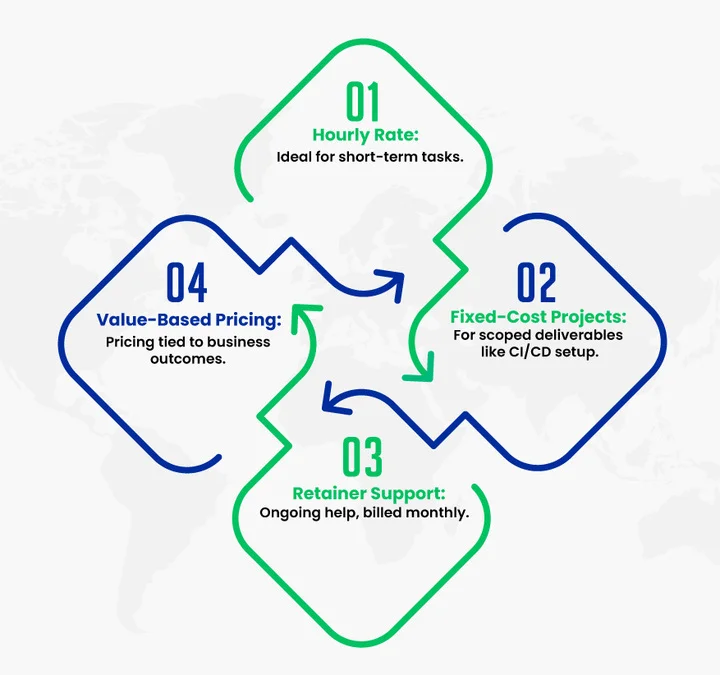
1. Hourly Rate Model
This pay-as-you-go model is ideal for early-stage startups seeking flexibility or one-off expert help. Hourly rates typically range from $75 to $250, depending on the consultant’s experience and region. It works best for debugging infrastructure issues, reviewing DevOps pipelines, or short-term advisory roles where the scope may evolve.
2. Fixed-Cost Projects
A fixed-price model suits startups with well-defined deliverables, like setting up CI/CD pipelines, implementing Infrastructure as Code (IaC), or configuring Kubernetes clusters. This model offers predictable DevOps consulting costs but requires a clear scope and limited revisions. Pricing ranges from $10,000 to $150,000+, based on complexity and timelines.
3. Retainer/Monthly Support
For growing tech companies scaling operations or undergoing multi-phase digital transformation, a monthly retainer ensures continuous access to a DevOps team. It covers ongoing maintenance, monitoring, performance tuning, and toolchain upgrades. Typical retainers fall between $3,000 and $15,000 per month. This model ensures continuity and proactive support.
4. Value-Based Pricing (ROI-Driven)
This model aligns DevOps consulting fees with business outcomes, like faster deployment cycles, reduced downtime, or improved cloud cost efficiency. It works best for mid-stage startups with defined KPIs and strong revenue models. Value-based pricing structures are custom-negotiated and often tied to metrics like time-to-market reduction or cost savings on cloud infrastructure.
Unsure which consulting model fits your team’s growth stage, budget, or internal capacity? We can help map the best fit for your needs.
How Is DevOps Consulting Cost Typically Broken Down?
DevOps consulting fees in 2025 are rarely a single line item. They’re often segmented across phases, platforms, and architecture complexity. For startups and growing tech companies, understanding these layers helps clarify cost structures and reduce budget surprises.
By Project Phase
DevOps projects usually follow a four-phase lifecycle. Each phase carries distinct time, tooling, and staffing requirements:
- Planning: Involves assessment, toolchain selection, infrastructure design, and roadmap creation. Typical cost: $5,000–$8,000.
- Implementation: Covers CI/CD pipeline setup, IaC deployment, containerization (e.g., Docker), and cloud provisioning. Range: $10,000–$40,000+.
- Optimization: Focuses on performance tuning, auto-scaling, monitoring (e.g., Prometheus, Datadog), and cost control. Cost: $5,000–$20,000+.
- Handoff: Includes documentation, team training, and post-deployment support.
- Range: $3,000–$10,000, depending on handover depth.
Each phase can be billed separately or bundled into a full-cycle engagement.
By Stack or Platform
Your technology choices impact pricing significantly. Here’s how major tools and platforms can shift consulting costs:
- AWS/GCP/Azure: Expect higher rates for multi-region cloud setups or compliance-heavy workloads.
- Kubernetes: Cluster setup and Helm chart configuration typically add $8,000–$20,000.
- Terraform (IaC): Basic IaC starts at $3,000, with complex modules pushing $15,000+.
- GitLab CI/GitHub Actions: Integration ranges from $2,000 to $10,000, depending on complexity.
Consultants with deep experience in specific stacks (e.g., AWS-certified architects, Terraform experts) often charge premium rates.
By Complexity
Project complexity is another key cost driver. More automation, more environments, and stricter compliance needs raise consulting time and tooling effort.
| Complexity Level | Typical Features | Estimated Range |
|---|---|---|
| Basic | Single environment CI/CD, IaC templates, basic alerts | $10,000–$25,000 |
| Mid-Level | Multi-environment setup, Kubernetes, cloud security | $25,000–$75,000 |
| Advanced | Multi-cloud, high availability, custom tooling, SRE | $75,000–$150,000+ |
Nonetheless, startups aiming for production-grade DevOps need to account for complexity beyond code deployment, especially when uptime, scaling, and security are business-critical.
What Hidden or Ongoing DevOps Costs Should You Expect?
DevOps consulting doesn’t end when the pipeline is built or the infrastructure is deployed. Startups and scaling tech companies should plan for recurring costs that continue long after initial implementation.
These hidden or ongoing DevOps expenses can quietly impact budgets if not factored in early:
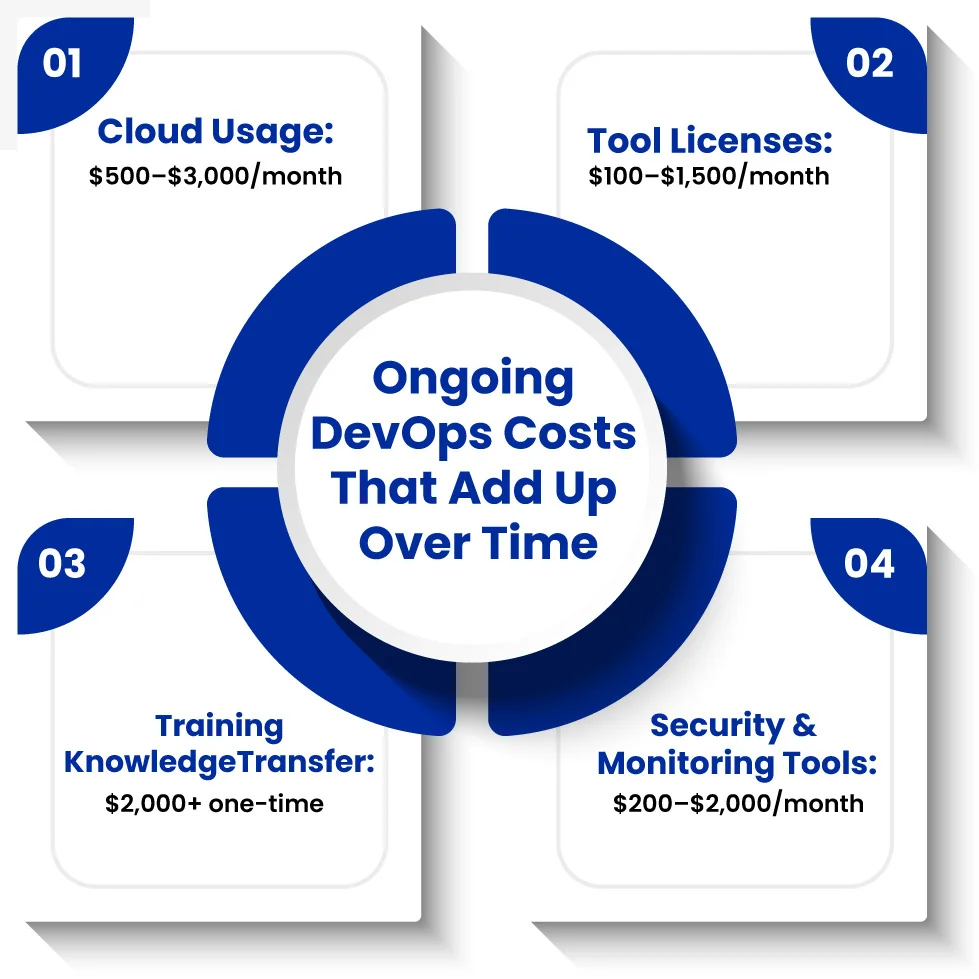
1. Infrastructure/Cloud Usage
Cloud infrastructure is often the largest ongoing cost. Usage-based billing models mean costs can scale quickly with traffic, storage, or compute demand. Common charges include:
- Compute instances (EC2, GKE, AKS): $100–$1,000+/month per environment
- Data transfer and storage (S3, Blob, GCS): $50–$500/month, depending on usage
- Load balancers and auto-scaling groups: $100–$300/month
Even modest production workloads can exceed $1,000–$2,000/month, particularly when not actively optimized.
2. Tool Licenses (Datadog, Sentry, etc.)
While many DevOps tools offer free tiers, production usage and enterprise features usually require paid licenses:
- Datadog: Starts around $15–$30 per host/month
- Sentry (error tracking): $29–$200+/month, depending on event volume
- Terraform Enterprise: From $20–$70 per user/month
These tools are essential for observability, but they can add hundreds to thousands of dollars annually to your DevOps budget.
3. Training or Knowledge Transfer
Knowledge gaps post-consulting can lead to missed ROI. Clients often need a budget for training internal teams or ongoing collaboration:
- Team training (live or recorded): $1,000–$5,000 per engagement
- Onboarding documentation & SOPs: May be included or billed separately
- Ongoing workshops or support hours: $100–$200/hour
Startups without in-house DevOps engineers should plan for regular check-ins or quarterly workshops to maintain system reliability.
4. Monitoring, Security, and Compliance Tools
As your stack grows, monitoring and compliance requirements increase. Failing to account for these tools can risk downtime or non-compliance.
- Security scanning (e.g., Snyk, Aqua): $500–$3,000/year
- Log management (e.g., ELK stack, Logz.io): $200–$1,000/month
- Audit/reporting tools for SOC2/GDPR: $1,000–$10,000+/year
Baking these tools into your DevOps budget from the beginning avoids scrambling later when security or audit needs emerge.
Want to spot hidden cloud cost leaks before they spiral?
Download our free Cloud Cost Optimization Checklist: a practical audit tool to help DevOps, engineering, and finance leads track usage, control spend, and align costs with delivery goals.
How Much Does DevOps Maintenance Cost After Implementation?
Once your DevOps setup is live, regular upkeep becomes essential. Maintenance ensures reliability, performance, and security don’t degrade over time, especially as systems evolve and workloads increase. For startups and scaling teams, budgeting for post-implementation DevOps support is non-negotiable.
1. Ongoing Monitoring & Incident Response
Monitoring uptime, performance metrics, and incident response is an active part of DevOps maintenance. This typically involves real-time alerting systems, log analysis, and response workflows during outages or anomalies.
Example: A growing SaaS startup may spend $2,000/month to maintain GitOps workflows, CI/CD pipelines, and 24/7 monitoring through a managed services provider or DevOps consultancy.
Services often include uptime dashboards, alert tuning, incident resolution, and runbook updates.
2. Updating Pipelines, Infra, and Scripts
As application code evolves, pipelines, infrastructure-as-code, and automation scripts must be updated accordingly. Tasks include:
- Adding new environments or deployment stages
- Refactoring Terraform modules or Helm charts
- Updating scripts for deprecated APIs or tools
This work is often handled as part of a monthly DevOps retainer or time-blocked support agreement.
3. Maintenance as a % of Setup Cost
A good rule of thumb: 10–25% of your original DevOps setup cost per year is a typical maintenance baseline. For example:
- A $40,000 CI/CD + IaC implementation might require $4,000–$10,000/year for updates, troubleshooting, and support.
- Monthly retainers range from $1,500 to $5,000+, depending on environment complexity, uptime SLAs, and response expectations.
Factoring this into your budget early helps avoid operational bottlenecks down the line.
How Does Clustox Approach DevOps Consulting for Startups?
Clustox works with early-stage and scaling tech companies to build DevOps foundations that match their current needs and grow with them. The focus is always on balancing speed, reliability, and cost control without overengineering or overcommitting resources.
Clustox follows the following process:

Discovery + Assessment
Every engagement starts with a discovery phase. Clustox conducts a structured assessment of the startup’s current infrastructure, deployment workflows, codebase, and team maturity. This includes reviewing CI/CD practices, cloud architecture, and current tooling. The goal is to identify friction points, automation gaps, and potential cost drivers early.
Tech Stack Alignment
Instead of pushing a fixed stack, Clustox aligns its recommendations with the client’s existing technologies and business goals. Whether a team is using AWS + GitHub Actions or GCP + GitLab CI, the DevOps design complements the tools already in use. Kubernetes, Terraform, Helm, Prometheus, or other components are introduced only if they solve specific scaling or reliability challenges.
Cost Transparency
All pricing is broken down clearly, by phase, by scope, and by resource. From day one, startups receive information about cloud usage estimates, optional versus necessary services, and any possible licensing fees. Clustox also supports cost monitoring integrations to help teams track and adjust their cloud spend in real time.
Measurable Impact
Progress is tracked using clear, relevant metrics such as deployment frequency, incident response time, and infrastructure stability. Instead of one-time rollouts, Clustox focuses on phased improvements with measurable outcomes.
- Example 1: A Series A B2B SaaS startup struggling with slow, manual deployments moved to an automated CI/CD pipeline with GitHub Actions and Kubernetes. Deployment frequency increased from twice a month to multiple times a day, cutting feature release delays by over 70%.
- Example 2: A healthcare analytics platform dealing with unpredictable downtime during high-traffic periods adopted a multi-zone Kubernetes setup with autoscaling and real-time monitoring. Uptime improved from 93.5% to 99.98% over two quarters, directly reducing churn and SLA violations.
These examples highlight the business-focused outcomes of Clustox’s approach, improving speed, reducing errors, and helping teams ship and scale with more confidence.
Learn more about Clustox DevOps Services and how they support product-focused teams without adding unnecessary overhead.
Want a second opinion on your current toolchain or cloud cost? Our engineers can walk through your tech stack and flag areas worth prioritizing.
What Are the Most Common DevOps Cost Pitfalls and How Can You Avoid Them?
Avoiding DevOps budget overruns starts with recognizing the patterns that commonly drive costs up without delivering real value. Startups and growing tech companies often face cost creep due to rushed decisions, unclear planning, or trying to do too much too soon.
Some typical startup errors that could blow your budget have been covered in the following, along with tips on how you can prevent them:
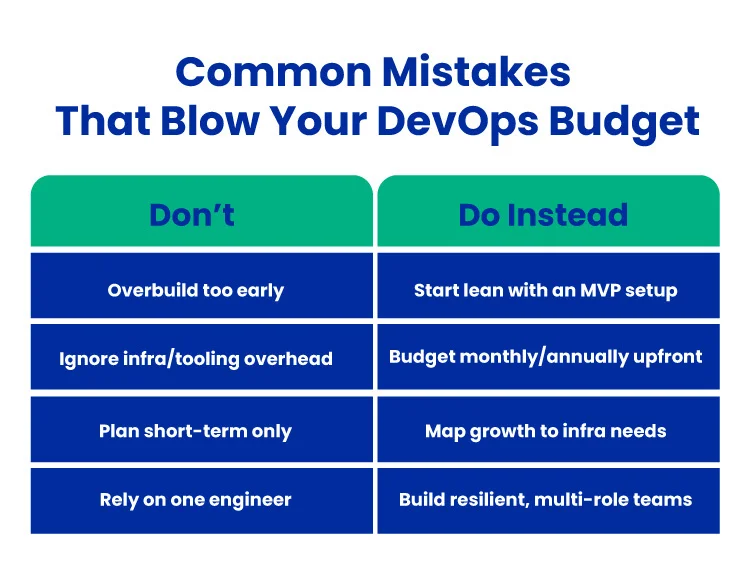
1. Overengineering Too Early
Startups sometimes invest in enterprise-grade infrastructure and tooling before they have consistent users or traffic. Deploying multi-cluster Kubernetes setups or complex service meshes in MVP stages is rarely necessary.
What to do instead: Start with lean, scalable building blocks. Use managed services whenever you can, and until growth justifies complexity, switch to simpler workflows like minimal IaC or GitOps. For example, use ECS or GKE Autopilot before jumping into a custom EKS or bare-metal setup.
2. Underestimating Infra and Tooling Cost
Teams often focus on consulting fees and overlook the recurring costs of tools, observability platforms, and infrastructure. Even basic monitoring stacks or log storage can add hundreds per month.
Budget tip: Build a 12-month cost projection, including licensing (e.g., Datadog, Sentry, Terraform Cloud), cloud compute/storage, backups, and traffic egress. Monitor actual vs. estimated usage monthly to adjust quickly.
3. Not Planning for Scale
It’s common to build an MVP and defer scaling concerns, only to face major rework costs later. Poorly structured pipelines or monolithic infrastructure may need complete re-architecture when usage increases.
What to do instead: Even at the MVP stage, include basic scalability hooks like auto-scaling groups, stateless app designs, or modular IaC. Plan CI/CD pipelines with reusable templates and branching strategies that can support more teams or services later on.
4. Relying on a Single DevOps Engineer
Hiring one in-house DevOps expert might look cost-effective, but it introduces bottlenecks and single points of failure. If that person leaves or gets overwhelmed, progress stalls.
Better approach: Consider part-time support from a consulting firm or a fractional DevOps team that brings collective expertise. This gives startups access to SREs, architects, and security engineers without hiring a full team.
In essence, avoiding these pitfalls requires not just technical judgment but financial foresight. Structured planning, modular tech choices, and an iterative rollout mindset can significantly reduce unexpected DevOps expenses.
What Does DevOps Consulting Cost Look Like in Real-World Scenarios?
DevOps consulting costs vary widely depending on the stage of your business, technical goals, and existing infrastructure. Here are three real-world startup and scale-up examples to show how scope, timeline, and budget typically align.
1. Startup Launching MVP
A pre-seed SaaS startup needed a CI/CD pipeline, basic IaC for AWS (VPC, ECS, RDS), and monitoring via CloudWatch and Sentry. The engagement focused on speed to deploy and cost control.
- Scope: CI/CD setup, IaC (Terraform), basic logging, and alerting
- Estimated Cost: $12,000–$18,000
- Timeline: 3–4 weeks
The consulting team used reusable Terraform modules and GitHub Actions to accelerate delivery while keeping infra costs below $300/month.
2. Fintech Scaling from 10k to 100k Users
A Series A fintech company needed a secure, scalable DevOps foundation. The engagement included GitOps adoption, zero-downtime deployments, observability tooling (Datadog, Prometheus), and cloud cost controls.
- Scope: GitOps rollout, staging/production parity, compliance-ready monitoring
- Estimated Cost: $80,000–$120,000
- Timeline: 8–10 weeks
Work included multiple AWS environments, pipeline hardening, and security integration for SOC 2 audit readiness.
3. SaaS Building SRE Culture
A mid-stage SaaS platform transitioning from ad-hoc ops to SRE practices needed SLIs, SLOs, auto-healing, and runbook development. They also requested training workshops for internal teams.
- Scope: SLO setup, incident response playbooks, Grafana dashboards, team onboarding
- Estimated Cost: $40,000–$60,000
- Timeline: 6 weeks
The focus was on long-term reliability. The consulting team deployed alerting systems, introduced chaos engineering exercises, and built an internal SRE knowledge base.
These examples reflect common needs and priorities for startups investing in DevOps consulting in 2025.
However, at Clustox, we understand that every business has unique DevOps needs depending on its product maturity, team capacity, and infrastructure goals. That’s why our consulting approach is never one-size-fits-all; we tailor each engagement based on your current stack, long-term vision, and operational priorities.
If you’re unsure what level of DevOps investment makes sense for your stage, we’re happy to walk you through options, budget ranges, and technical trade-offs.
Contact us to start a conversation or get clarity on your next steps.
How Can You Estimate and Plan Your DevOps Budget Wisely?
Effective DevOps budgeting starts with clear planning and ends with validated execution. Many startups fail because they only consider the initial expenses, neglecting the maintenance or scaling requirements over time.
Startups can estimate and plan their DevOps budget by following the steps below:
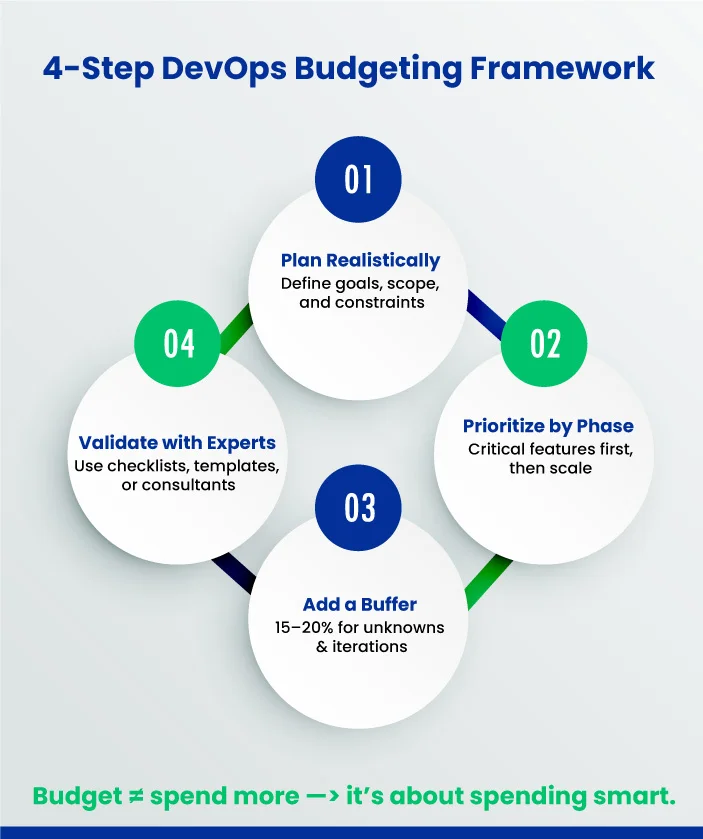
Budgeting for Initial Setup vs. Scale
Start by distinguishing between your MVP or pilot setup and what’s needed at scale. Initial setup often includes CI/CD pipelines, IaC provisioning, and basic monitoring. This phase can range from $10,000 to $50,000, depending on complexity.
Further, planning for growth, auto-scaling, role-based access, cost monitoring, and compliance might add another $20,000 to $100,000+ over time. Build both phases into your roadmap early.
Prioritizing Features & Phases
Avoid trying to implement everything at once. Use a phased approach to roll out key DevOps functions, starting with version control, CI pipelines, and infrastructure provisioning. Phase two can include security scanning, observability, and auto-remediation. This avoids overengineering before it’s necessary and helps manage cash flow.
Adding a 15–20% Buffer
Unexpected needs often emerge mid-project, changes, compliance requests, or new integrations. Add a buffer of 15–20% to your estimated budget to account for unknowns. This avoids approval delays or scope compromise down the line.
Getting External Help
If your in-house team lacks DevOps expertise, bringing in a consulting partner can prevent costly missteps. External firms often bring proven templates, Terraform modules, pipeline blueprints, and security baselines. These shorten delivery time and reduce rework costs.
To summarize, structured planning not only improves budget accuracy but also ensures each dollar contributes to long-term operational resilience.
How Can You Reduce DevOps Services Costs Without Compromising Quality?
Lowering DevOps consulting expenses doesn’t mean sacrificing performance or security. Smart startups reduce spending by making lean, high-impact choices, especially during early stages.
Here’s how:
Start With MVP Scope
Avoid building for scale before you have users. Focus on what’s necessary to ship and iterate. CI pipelines, basic IaC, and minimal monitoring often cover the first 80% of needs. Delay complex features like advanced autoscaling, service mesh, or multi-cloud configs until traction justifies it.
Reuse Tools or IaC Modules
Use proven, reusable infrastructure code, open-source Terraform modules, Helm charts, or CI pipeline templates. These cut down implementation time and reduce consulting hours, leading to a reduction in the cost of DevOps implementation. Tools like GitHub Actions, GitLab CI, and Kubernetes Operators also offer solid defaults that don’t need custom builds.
Choose Cross-functional Teams
Instead of hiring multiple specialists, work with consultants or firms that bring DevOps engineers experienced in cloud, automation, and security. Cross-functional pros reduce handoff gaps and streamline delivery. One experienced engineer can replace the need for 2–3 siloed roles during MVP.
Outsource Wisely
Engage boutique firms or individual consultants with proven track records and documented frameworks. They often deliver faster using prebuilt assets and require less oversight. Retainers for maintenance post-launch ($2,000–$5,000/month) are often more economical than trying to scale an internal team too early.
What Kind of ROI Can You Expect from DevOps Consulting?
Investing in DevOps consulting isn’t just about building pipelines or migrating to Kubernetes; it’s about improving how your tech team delivers, scales, and operates. When done right, the return on investment goes beyond cost recovery and directly supports business growth.
1. Time to Market
A well-structured CI/CD pipeline drastically cuts time spent on manual deployments and release coordination. Many startups see feature delivery cycles drop from weeks to days. Faster feedback loops and shorter release timelines help capture user interest earlier and iterate faster on customer needs.
2. Stability & Incident Reduction
DevOps brings consistency across environments through Infrastructure as Code (IaC) and automated testing. This reduces human error and environmental drift. Teams experience fewer outages, faster rollbacks, and lower mean time to recovery (MTTR). For early-stage companies, fewer production issues mean better user retention.
3. Infrastructure Cost Savings
DevOps helps identify resource over-provisioning and optimize cloud usage with autoscaling, right-sizing, and clean shutdown policies. This can cut cloud bills by 20–40% in many cases. Moving to spot instances, setting up proper alerts, and optimizing storage also yield measurable savings.
4. Team Productivity Boost
Manual work like setting up staging servers, debugging flaky deployments, or babysitting infrastructure eats into developer time. Automating these tasks gives engineers more focus on product development. This not only boosts morale but also improves output velocity.
| ROI Area | Result | Example |
|---|---|---|
| Time to Market | Releases go from bi-weekly to daily | MVP launched in 4 weeks instead of 10 |
| Stability | Fewer incidents, faster recovery | 35% drop in production bugs post-IaC rollout |
| Infra Cost Savings | Lower monthly cloud spend | $3,000/month saved by rightsizing VMs |
| Team Productivity | More engineering time for the product | 20% increase in sprint velocity after CI/CD |
These returns validate the importance of planning your DevOps budget around outcomes, not just implementation tasks.
Want to measure the actual ROI of DevOps in your business context? From incident reduction to faster rollout, we’ll help you map the potential impact.
Frequently Asked Questions (FAQs)
Can I hire a DevOps team part-time or on a retainer?
Yes. Many startups begin with part-time retainers for 20–40 hours/month, especially for support, automation updates, or incident response. Monthly retainers generally start around $3,000 to $7,000 and scale with scope. This approach is common for phased rollouts or ongoing reliability work.
How much should a Series A company budget for DevOps consulting?
A Series A company typically allocates $50,000 to $150,000 across multiple phases, covering CI/CD pipelines, cloud infrastructure, IaC, and monitoring. This often includes both setup and 3–6 months of support. Cost depends heavily on team size, platform (e.g., AWS vs. Kubernetes), and compliance needs.
Is it better to outsource or build an in-house DevOps team?
Outsourcing is ideal for speed, flexibility, and niche expertise, especially in early stages. In-house hiring makes sense for product-mature teams with steady workloads. Many startups adopt a hybrid approach, outsourcing architecture and automation, then hiring internally for ops continuity.
What services do DevOps consulting packages usually include?
DevOps consulting often includes CI/CD setup, IaC development, observability tooling, cloud architecture, security automation, and documentation. Some firms also handle incident response playbooks, developer workflows, and cost monitoring integrations. The scope is often modular based on the growth stage.
How do DevOps consultants work with existing engineering teams?
Most consultants embed into engineering workflows, align on sprints, and document infrastructure decisions clearly. Collaboration tools like GitHub, Jira, and Slack are common. The goal is to build systems that engineers can own, not create vendor dependency.
Can DevOps consultants help reduce cloud and tooling costs?
Yes. Experienced consultants audit cloud usage, remove underused services, configure auto-scaling, and recommend cost-efficient tooling stacks. For example, switching to open-source observability tools or spot instances on AWS can cut infra costs by 20–40% in some cases.
What should you look for when choosing a DevOps consulting firm?
Look for a firm with transparent pricing, proven startup experience, and expertise in your tech stack (e.g., Terraform, GitLab, Kubernetes). Ask about their approach to handoff, documentation, and cost planning. Case studies, client references, and clarity on team structure are also good signs.
Final Thoughts
DevOps consulting isn’t a one-size-fits-all investment; it depends on the tech stack, architecture complexity, scope, and preparedness of your internal team. This guide covered how costs break down across engagement models, infrastructure requirements, tool licenses, and long-term maintenance needs. We also outlined typical pricing ranges based on project phase, startup stage, and business goals.
For early-stage companies, the smartest use of DevOps spend often involves starting lean, prioritizing automation that directly supports product delivery, uptime, and customer experience. Later-stage or scaling teams may focus more on modularization, security hardening, and cost optimization through the use of infrastructure-as-code and monitoring tools.
The key takeaway: cost should always align with return. DevOps investments are only worthwhile if they result in quantifiable benefits, such as a quicker time to market, fewer on-call hours, or better use of engineering time.
Before committing to any engagement, it’s crucial to outline your priorities, timeline, and internal capabilities. This allows consultants to scope realistic, phase-wise estimates that fit your business without overengineering or overspending.
If you’re planning a new deployment, migration, or automation initiative in 2025, consider getting a tailored DevOps estimate based on your team size, tech stack, and infrastructure. It’s the clearest way to align expectations, reduce waste, and build efficiently from day one.
Your DevOps costs don’t have to be a mystery. Clustox helps startups build clear and scalable plans, from scope to execution. Let’s put real numbers to your roadmap.

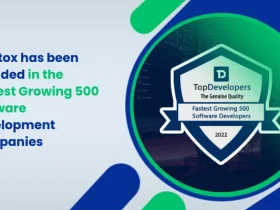


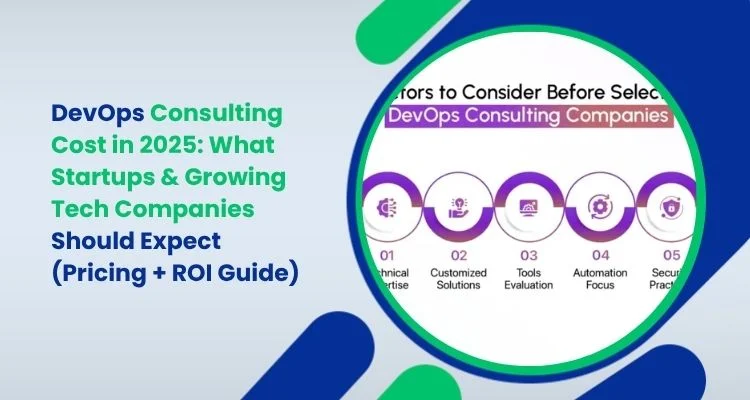

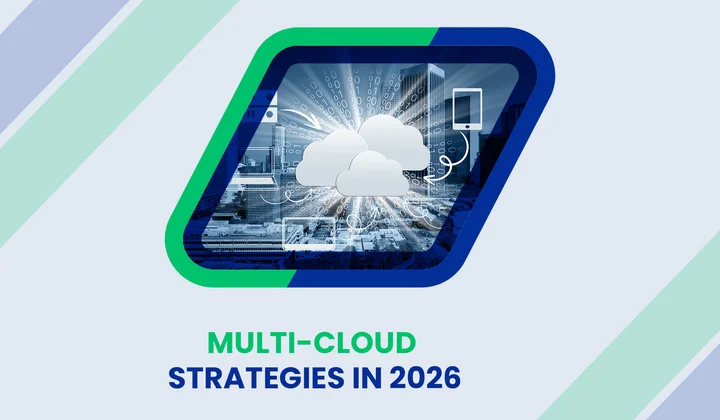
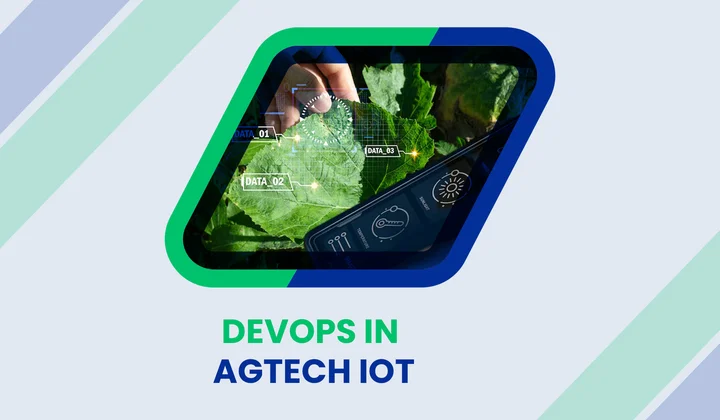
Share your thoughts about this blog!